Exploring the Best Languages to Develop REST API

REST APIs are regarded as the backbone of modern software development. In order to reap the benefits of these APIs and build REST APIs that are efficient, secure, and scalable, you need to use the right programming language.
In this blog post, we are going to help you out in this regard and introduce the 5 best languages that you can employ to develop REST APIs.
What is a REST API?
A REST API, or RESTful API, is a type of application programming interface that adheres to the principles of REST architecture. In order for an API to be considered RESTful, it must conform to a number of certain principles:
- It should involve separate client and server components that interact using HTTP requests.
- Communication between the client and server should be independent, with no need to store information about previous requests.
- Data should be designed to be easily cached to improve performance.
- Information should be shared in a standardized format across the system.
- The API should be structured in layers, with different servers handling tasks such as security and load balancing.
REST API Features
REST APIs have several essential features that make them easy to grow and manage. Let’s take a look at the 5 main characteristics of REST APIs.
1. Statelessness
The most important feature of REST APIs is their stateless nature. Each request from a client to a server is self-contained, i.e. it includes all the necessary information without relying on previous interactions.
To maintain security, every request typically includes authentication details. Although this increases the size of each request, it allows the server to handle multiple requests efficiently without the need to store user data between interactions.
2. Client-Server Architecture
REST APIs operate on a client-server model. This means that applications (clients) request information from a server, which then provides a response.
The benefit of this setup is that it allows developers to work independently on the client and server components. As a result, it will be easier to build, maintain, and expand the system.
3. Uniform Interface
Having a uniform interface is another characteristic of REST APIs. By using standard methods such as URIs to locate data and HTTP commands (GET, POST, PUT, DELETE) to manipulate it, REST APIs become easier to design and understand.
This shared language between computers and applications contributes to efficient communication.
4. Catchability
Another feature of REST APIs is their use of caching to improve performance. They store frequently accessed data temporarily to avoid repeatedly fetching it from the server. When a request is made, the system checks the cache first.
If the data is available there, it is quickly delivered without involving the server. Developers can specify which data can be cached. By using cached data, response times are considerably faster, and the server’s workload will be reduced.
5. Layered Structure
REST APIs are structured in layers. In other words, clients interact with a single main server while the server can communicate with multiple internal systems. This setup simplifies development by isolating different parts of the system.
For instance, if the server changes how it handles traffic and load balancing, the client will not be affected and can continue to communicate as usual.
Overall, this layered approach allows for flexibility and easier maintenance without disrupting the client’s experience.
How Do REST APIs Work?
REST APIs make use of HTTP requests to interact with databases. They perform standard database operations such as creating, reading, updating, and deleting data.
For example, to get information, a GET request is sent; to add new data, a POST request is used; to modify existing data, a PUT request is employed; and to remove data, a DELETE request is made.
These APIs function similarly to websites since they use HTTP and represent data as it exists at a specific moment.
Rest API Use Cases
The RESTful approach is ideal for cloud services since it simplifies the connection between services by managing how web addresses are interpreted.
Given the rise of cloud computing and microservices, it is quite likely that RESTful API design will become the standard down the road.
REST APIs are commonly used in mobile and web applications to access and modify data from remote systems. While they have numerous applications, some of the most familiar examples include:
- Mobile apps like ride-sharing services rely on REST APIs to access maps and manage bookings.
- Banking apps use REST APIs to retrieve account information and process transactions.
- Streaming platforms make use of REST APIs to deliver media content from remote servers.
- Social media platforms take advantage of REST APIs to create, manage, and share posts. They also use them to connect with other apps.
Best Languages for REST APIs
In what follows, we will examine the best programming languages available that you can rely on for your REST API development projects.
1. Python
Python is a popular choice for creating REST APIs due to its simplicity and clear code structure. Another benefit of Python is that it has an extensive collection of libraries and frameworks, such as Flask and Django, that simplifies the API development process.
Moreover, Python’s capabilities in data analysis and machine learning make it ideal for building APIs to support applications in these fields.
Why You Should Pick Python for REST APIs
You should select Python for developing REST APIs for many reasons, including:
- Ease of Use: Python has a simple syntax and a large developer community.
- Comprehensive Toolset: Python gives you access to abundant libraries and frameworks like Flask and Django.
- Data Compatibility: Python offers built-in support for common data formats including JSON and XML.
- Performance and Scalability: Python is capable of handling large-scale API deployments efficiently.
Limitations of Python
If you are considering Python for your REST APIs, there are a number of shortcomings that you need to take into account.
- Speed: Python’s performance is considered slower than compiled languages such as C++ or Java.
This is because Python code is executed line by line by an interpreter, unlike compiled languages which are converted into machine-readable code before running. - Security: Given its dynamic typing system, Python is generally considered less secure than languages like Java or C++. This issue is likely to raise the risk of security vulnerabilities including buffer overflows and injection attacks.
- Memory Usage: Another drawback of Python is its memory usage. Python’s dynamic nature often results in higher memory consumption compared to compiled languages. This can be problematic, particularly for applications with limited resources.
2. Java
Another popular choice for developing REST API is Java. Java is a structured and object-oriented language which is widely used in large-scale systems. With libraries like JAZ-RS and frameworks such as Spring Boot, Java supports building RESTful APIs.
Why You Should Pick Java for REST APIs
These are the reasons why to consider Java as a great option for developing REST APIs.
- Strong Typing and Robust Frameworks: Java’s strict data typing and mature tools like Spring Boot, Apache CXF, and Restlet streamline API development, especially for large-scale projects.
- Developer Productivity: Powerful IDEs and a vast community support efficient development and problem-solving.
- Reliability: Java’s platform independence and extensive documentation guarantee wide deployment and maintainability.
Limitations of Java
Java has a few downsides that you should consider when deciding to use it for your REST API development.
- Performance: One of the drawbacks of Java is related to its performance. Java’s performance is slower than native languages such as C++. This is primarily due to the overhead of the Java Virtual Machine and its automatic memory management.
Other factors including garbage collection, inefficient caching, and thread synchronization further affect Java’s performance if not carefully managed. - Complexity: Java has a complex and lengthy syntax. Its code requires more lines to accomplish the same task compared to simpler alternatives such as Python or C++.
- GUI Challenges: Java GUI development is hindered by inconsistencies and a lack of native-looking interfaces. Although there are frameworks to aid in this process, they mostly fall short in creating sophisticated graphical user interfaces.
3. PHP
PHP is a widely-used language for creating REST APIs. As a server-side language with a long history and a vast developer community, PHP offers several well-known frameworks including Laravel and Symfony, which simplify and expedite the process of building REST APIs.
Why You Should Pick PHP for REST APIs
Let’s see what the advantages of PHP are that make it a good choice for developing REST APIs.
- Accessibility: The most important advantage of PHP is that it is easy to pick up and use, with a straightforward syntax and a large community for support.
- Robust Ecosystem: Frameworks like Laravel and Symfony provide powerful tools to simplify API development.
- Data Compatibility: PHP has built-in support for standard data formats such as JSON and XML.
- Scalability: PHP can handle high traffic and large-scale API deployments effectively.
Limitations of PHP
Keep in mind that PHP, like any other language, has a number of shortcomings. These are:
- Limited Debugging: Compared to other scripting languages, PHP struggles to effectively identify and pinpoint errors. Because of this, troubleshooting becomes a more challenging task for developers.
- Security: Since PHP code is publicly accessible in plain text format, potential attackers can easily view the code, identify vulnerabilities, and exploit them. So, technically speaking, PHP can be more susceptible to security breaches.
- Not the Easiest Language: Another issue is that PHP is challenging to read and learn.
While it is relatively easy to pick up for experienced developers, its code structure is less intuitive compared to languages like Python. Thus, PHP may not be the best choice for beginners.
4. Golang
Golang, also known as Go, is a fast and efficient programming language known for its simplicity and ability to handle multiple tasks simultaneously.
What’s more, it includes built-in tools for creating web applications, and thus, it is well-suited for building REST APIs.
Why You Should Pick Golang for REST APIs
If you want to know the reasons that make Go a well-suited option for REST API development, have a look at the advantages below.
- Concurrency: Go is capable of handling multiple tasks simultaneously, making it ideal for microservices and distributed systems.
- Developer Efficiency: Thanks to its clean syntax and built-in tools, Go accelerates the development process.
- Performance: Go offers high speed comparable to other compiled languages.
- Rich Ecosystem: Go has a growing collection of frameworks and libraries, such as Gin and Gorilla, that aid in API development.
Limitations of Golang
Now that you know how Golang benefits your REST API development efforts, it is a good idea to take a look at some of its cons.
- Time-Consuming: Compared to more expressive languages like Python, Go requires more code to accomplish the same task.
- Limited Libraries: Go has a less extensive library compared to other languages in the market. So, you will need to rely on external libraries for specific functionalities.
- A Young Language: Go is considered a young language so it has a relatively immature ecosystem. For this reason, developers will have a hard time finding the necessary tools and resources for their development tasks.
5. C#
The final language that we are going to discuss here is C#. C# is a versatile programming language developed by Microsoft that combines the power of C++ with the ease of use of Visual Basic.
It is part of the .NET framework and offers a rich set of tools and libraries for building applications.
Why You Should Pick C# for REST APIs
C# can be a great choice when it comes to REST APIs because:
- Integration: C# provides seamless integration with Visual Studio and Visual Studio Code.
- Testing Support: C# also offers built-in tools for unit testing API endpoints and isolating components.
- Rich Ecosystem: With C#, you will be able to access a vast collection of libraries and packages for various functionalities.
- Scalability: C# can handle increasing workloads on both Windows and Linux platforms.
Limitations of C#
Despite the advantages that we mentioned, using C# for developing REST API comes with certain shortcomings.
- Learning Curve: The most obvious disadvantage of C# is its steep learning curve. Mastering the language itself is challenging, and understanding the complex .NET ecosystem will be a lot to take in for developers.
- Performance Issues: C# is regarded as a slow programming language. This arises from the way C# is processed.
Unlike other languages, which compile directly to machine code, C# code is first converted into an intermediate language and then into machine code. - Compilation: C# is a compiled language. While compilation can be advantageous when it comes to performance, it is inconvenient as any code change, no matter how small, needs a rebuild of the entire project.
Final Words
If you need help with your REST API development tasks, we at BSUPERIOR can help you. BSUPERIOR is a software development company that specializes in building cutting-edge REST API solutions tailored to your unique business needs.

With a deep understanding of today’s complex business landscape, we empower organizations to optimize operations, foster innovation, and enhance customer experiences through secure and reliable APIs.
Contact us today to get more information. Feel free to explore our services and embrace superior technology with us
We value your input and believe this content may enhance our services. However, it's under review. If you see room for improvement, please use the "Report an issue" button below. Your feedback helps us excel.
Contact us today at –– and speak with our specialist.




